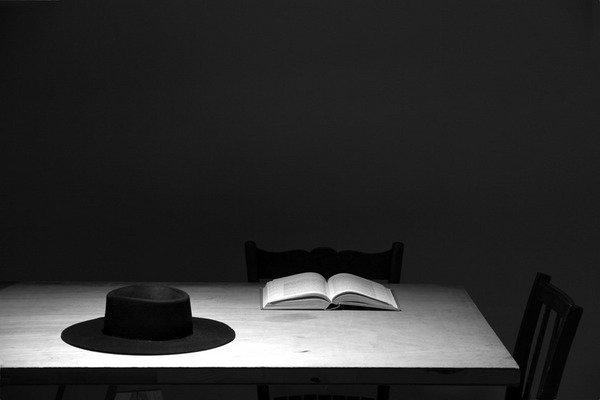Two exhibitions
dal 5/9/2013 al 25/10/2013
Segnalato da
5/9/2013
Two exhibitions
Meessen De Clercq, Bruxelles
Concepts such as balance, fragmentation, deliberate distance, the distortion of vision are constantly used by Leon Vranken who also has a humorous view of the world. Jorge Mendez Blake deepens his research on literature and complexities of language by focusing on Samuel Beckett.

Leon Vranken
A Cat’s Eye Perspective
For his first solo exhibition at the gallery, Leon Vranken (born 1975) is taking over the exhibition
space with a proposal that perfectly illustrates the plastic research he has been carrying out for
several years. Noticed in 2009 at the Young Belgian Painters Award with an installation that
destabilized the viewer's perception, Vranken is now deepening this approach by playing with
perspective and the loss of contact with reality.
Paradoxically, he seems to want to help the visitor
to stay in contact with reality by placing a handrail all along the exhibition walls. This invitation
quickly turns absurd since the space is rather cramped and objects and frames are propped up
against the handrail. The perspective is distorted, causing the viewer to doubt what he/she is
seeing. The discrepancy between a real object and the representation of the same object
accentuate the disorientation of the visitor and are reminiscent of what fascinated Magritte. The
optical illusion is a device that pervades the history of art and Vranken gives us some splendid
examples. The two large photos hung on the wall are reproductions of paintings by the artist,
photographed and printed before being placed behind cut or perforated glass. Is this multiplication
of filters not a splendid metaphor for the complexity with which reality can be perceived?
Concepts such as balance, fragmentation, deliberate distance, the distortion of vision are
constantly used by the artist who also has a humorous view of the world as can be seen in his
work/fountain, Study for a vertical line, presented in the Middelheim Museum in Antwerp.
In the centre of the spaces are scattered sculptures, whose forms refer to each other in a playful
way and a showcase containing various items from the artist's studio reproduced exactly but in
wood. Being shown in this way, these everyday objects (altered by traces of paint that unite them)
assume an undeniable museum status. The monstration of works and objects is a subject of
profound interest to the artist, and we can feel that through various pedestals (real or
photographed) visible throughout the exhibition. Gifted with a remarkable talent for any type of
carpentry, Vranken makes everything himself, which allows him to create all his pedestals and to
have fun mixing styles and conventions. At present, in the centre of Antwerp, he is showing a
sculpture/plinth to mark the 350th anniversary of the Academy, which questions the idea of the
monument and its presentation to the public.
--------
Jorge Méndez Blake
Nothing is Left to Tell
With Nothing is Left to Tell, his third exhibition at the gallery, Jorge Méndez Blake deepens his
research on literature and complexities of language by focusing on the Irish writer Samuel Beckett
(1906-1989), winner of the Nobel Prize for Literature in 1969. The Mexican artist based his
research on the very short play Ohio Impromptu which contains some of the major
Beckett themes: isolation, a communication gap, duality, rehashing of words, contemplation of
emptiness, allusion to death. These themes are re-assessed throughout the exhibition through
various media.
The large drawing of a curtain, the theatrical artifice par excellence, opens the question of
representation: what to show/what to say? What to watch? Who to listen to? The curtain is a
mask and arouses curiosity. Another question comes from the mirror, which reflects and
duplicates. This mirror, often found in Méndez Blake's work, is placed on a table in closed form.
Does repeating infinitely lead to dementia or an ecstatic contemplation? How to approach the
couple, which is alluded to here through these two chairs next to each table but also by the
photographic diptych, visible from a precise perspective? What to say to the other person? The
big picture of the final page Ohio Impromptu, enlarged and drawn in fine coloured pencil, suggests
that there is little that can be said with this sentence, reproduced in red, endlessly repeated
throughout the piece: Nothing is Left to Tell. A certain emptiness beautifully emphasised. Language is
also suggested repeatedly through a series of works on paper reproducing the words Rideau /
Curtain which correspond to the words at the end of Beckett’s plays. By avoiding all text, Méndez
Blake creates a fine allusion to the strangeness and abstraction of Beckett's work. The place of
words and colour are chosen according to a precise logic, like the layout of the series itself (the
opening itself becoming an invisible curtain).
Using a large dark velvet curtain separated into two sections, the artist installs a theatrical device
that opens and closes the spoken word. This raises the more general question of representation:
two large black rectangles painted on the wall act as the shadows of the curtain and a bronze hat
echoes the photographic diptych. Opposite this darkness, he has spread out four large drawings of
flowers growing near the artist's studio in Guadalajara. They seem to be drawn in filigree, seen
through a veil (the curtain again), paying homage to Beckett's most optimistic moods; one reads in
Enough: "I'm going to erase everything except the flowers. (...) Just the two of us lingering in the flowers ".
Image: Jorge Méndez Blake
Meessen De Clercq
Abdijstraat 2a Rue de l'Abbaye 1000 Brussels, Belgium
Opening hours:
Tuesday - Saturday 11am - 6pm



